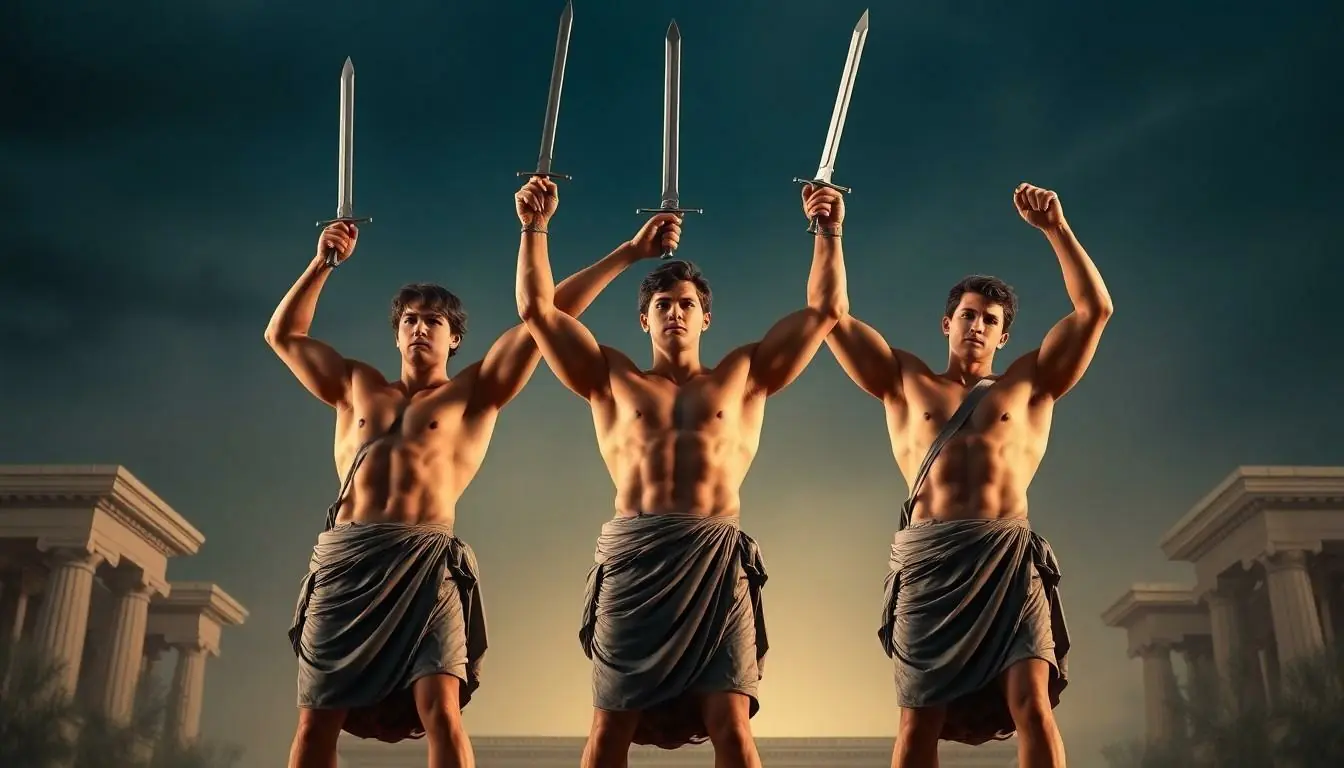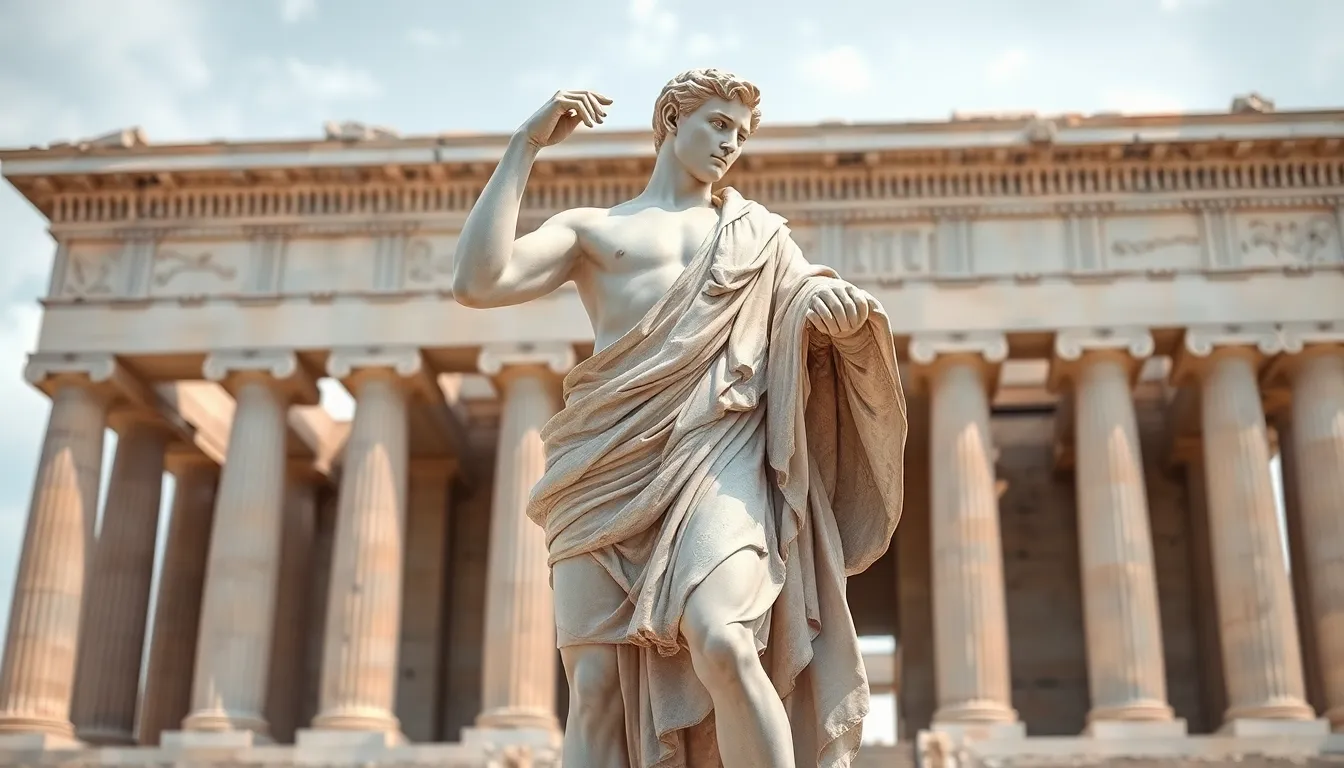In the realm of art, few pieces spark as much intrigue as Jacques-Louis David’s Oath of the Horatii. This dramatic masterpiece doesn’t just capture a moment; it transports viewers to a time when honor and loyalty ruled supreme. But what’s the secret sauce behind its captivating allure? Spoiler alert: it’s all about the classics!
Table of Contents
ToggleOverview of David’s Oath of the Horatii
Jacques-Louis David’s painting, Oath of the Horatii, serves as a striking representation of themes such as honor and loyalty. This artwork draws heavily from classical Greek and Roman artistic traditions, which enhance its lasting appeal.
Historical Context
The painting emerged in 1784, during a period of political upheaval in France. David’s portrayal of three brothers pledging allegiance reflects the values of the Roman Republic, symbolizing courage and sacrifice. The backdrop of the painting encapsulates the tension between personal loyalty and civic duty. Additionally, references to the Horatii family depict a narrative steeped in ancient Roman history, resonating deeply with contemporary viewers. The historical allusions reinforce communal values just as the French Revolution began to take shape.
Artistic Significance
David’s mastery is evident in the composition and style of the painting. The triangular arrangement of the figures creates a sense of stability and unity, common in classical art. Color usage enhances the drama of the scene, with bold contrasts spotlighting the central figures. His technique incorporates classical influences, such as the sculptural quality of the figures and the grandeur of the setting. Emotional expressions on the characters’ faces communicate themes of determination and resolve, appealing to viewers’ sentiments. Overall, the painting functions as a bridge between the classical past and the contemporary ideals, preserving its emotional weight and artistic relevance.
Influence of Classical Greek Art

Classical Greek art significantly influenced David’s Oath of the Horatii. This impact manifests through various elements that reflect ancient traditions and ideals.
Use of Idealized Forms
Idealized forms characterize much of classical Greek art. Sculptors depicted figures with proportional beauty and perfect anatomy, showcasing the human body’s potential. David adopted this concept, emphasizing the strength and heroism of the Horatii brothers. The brothers’ muscular physiques echo the athletic ideals celebrated in ancient Greece. Every figure possesses a noble appearance, reinforcing the themes of honor and valor. David’s attention to detail enhances their heroic stature, aligning with the classical tradition of presenting characters as paragons of virtue. This stylistic choice elevates the emotional weight of the scene, connecting historical significance to visual representation.
Composition and Perspective
David’s composition reflects principles of balance prevalent in classical art. He arranges the figures in a triangular formation, promoting stability and focus. This layout draws the viewer’s eye to the central action, emphasizing the oath-taking moment. Naturalistic perspective enhances the three-dimensionality of the scene, contributing to its dramatic effect. David employs a strong linear perspective, guiding viewers into the depth of the setting. By utilizing architectural elements, he establishes a direct connection between the foreground and background. Each aspect of the composition serves to heighten the narrative intensity, evocative of classical storytelling methods.
Influence of Classical Roman Art
David’s Oath of the Horatii draws heavily from classical Roman art, not only in style but also in the underlying themes it depicts. Classical art often celebrates values such as patriotism and sacrifice, resonating profoundly in David’s work.
Themes of Patriotism and Sacrifice
Patriotism forms a cornerstone of Oath of the Horatii, mirroring ideals prevalent in Roman culture. The painting illustrates three brothers who pledge loyalty to their country, symbolizing selflessness and courage. Sacrifice remains integral to the narrative, showcasing the tension between personal desire and civic duty. Roman artworks frequently elevate such themes, and David mirrors this tradition by emphasizing the emotional weight of the brothers’ oath. Their resolve encapsulates the spirit of sacrifice, which historians cite as pivotal in nurturing national identity.
Sculpture and Architectural Elements
Structural elements in Oath of the Horatii echo the grandeur of Roman architecture. David employs triangular composition, reminiscent of classical sculptures, to convey strength and stability. This arrangement directs viewers’ attention toward the central act, enhancing the scene’s drama. Architectural features, such as columns in the background, provide context while reinforcing the painting’s connection to Roman civic life. These design choices not only elevate the visual impact but also reflect the melding of sculpture and painting, characteristic of Roman artistic tradition.
Comparison with Other Works
David’s Oath of the Horatii embodies elements from classical art, drawing parallels with both Greek tragedy and Roman mosaics.
Similarities to Greek Tragedy
Themes of heroism and moral conflict in David’s work resemble those found in Greek tragedy. The brothers’ oath evokes the dramatic tension typical of classical plays. Each character displays a heightened emotional state, reflecting the tragic outcomes faced by heroes in ancient dramas. Movement and stoic expressions emphasize their commitment to honor and loyalty, mirroring the gravitas of tragic figures. This emotional depth enhances viewer engagement, bridging the gap between visual art and performative storytelling.
Reflections in Roman Mosaics
Roman mosaics also inform the composition of Oath of the Horatii. The arrangement and narrative clarity seen in mosaics resonate prominently within David’s painting. Color palettes and attention to detail align with the intricate designs of Roman art. Mosaics often depicted valorous acts, mirroring the commitment and sacrifice portrayed in David’s work. Furthermore, architectural elements within the painting reflect the grandeur characteristic of Roman spaces, asserting a strong connection to civic ideals and a sense of place.
David’s Oath of the Horatii stands as a testament to the enduring influence of classical Greek and Roman art. Through its idealized forms and powerful themes of honor and sacrifice, the painting captures the essence of civic duty that resonates across time. The meticulous attention to composition and detail not only highlights the strength of the Horatii brothers but also reinforces the connection to classical traditions. This masterpiece bridges the gap between historical ideals and contemporary values, ensuring its relevance in the narrative of art history. As viewers engage with the emotional depth and dramatic tension, they are reminded of the timeless nature of heroism and loyalty, making David’s work a pivotal point in the evolution of neoclassical art.





